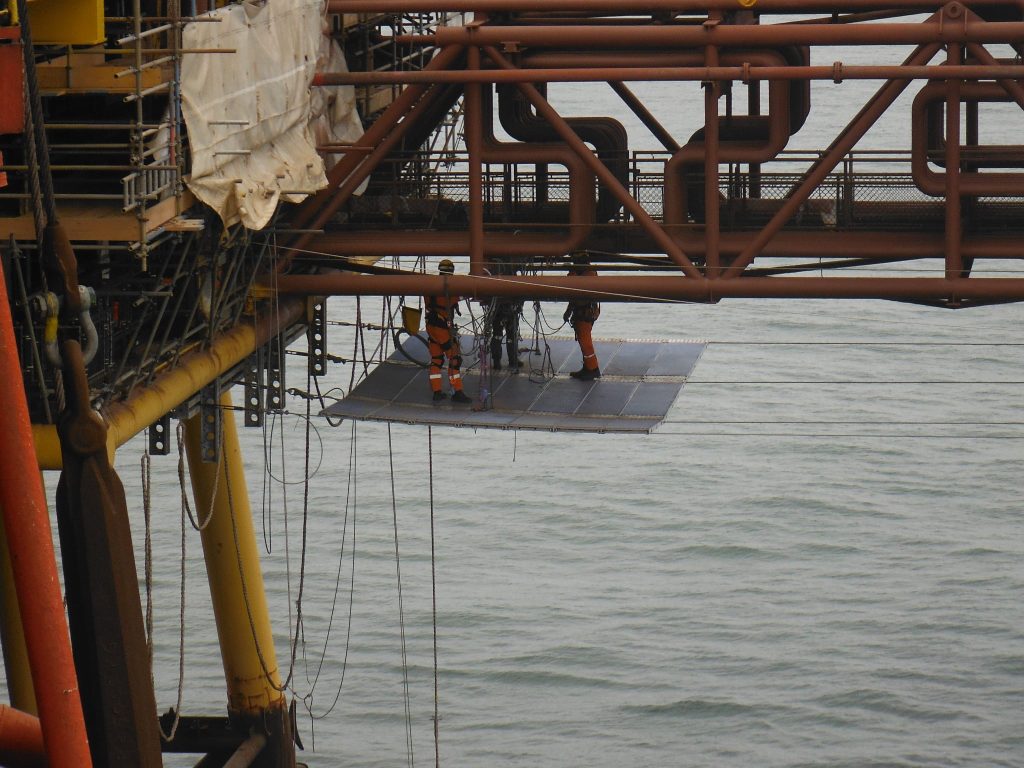
In the world of construction and maintenance, accessing high and hard-to-reach areas can be a significant challenge that requires extensive planning. Unlike traditional scaffolding, which is built from the ground up, suspended scaffolding provides a flexible, space-saving, and efficient way to reach elevated work areas by suspending a platform from an upper level. Whether it’s for blasting, painting, or structural repairs, suspended scaffolding is widely used across various industries for jobs that require work at considerable heights.
What is Suspended Scaffolding?
Suspended scaffolding consists of a platform that hangs from the roof or overhead structure using slings, cables, chains or similar suspension systems. This type of scaffolding is ideal for at height work where ground-supported scaffolds would be less practical. The platform can be adjusted vertically to suit different work heights, making it an ideal solution for tall structures like pipe racks, bridges, conveyors or jetties.
Key Advantages of Suspended Scaffolding
- Accessibility – One of the primary advantages is its ability to provide access to areas that would be challenging or even impossible to reach with other types of scaffolding or equipment. This makes it particularly useful for work executed over waterways or active roadways. Suspended scaffolding can be used to create access to work areas above uneven or non-bearing surfaces, water, traffic routes, or areas obstructed by elements such as tanks, pipes, or machinery.
- Efficiency – Suspended scaffolding is highly efficient in terms of both time and resources. It minimizes the need for bulky ground-based scaffold systems, which can be time-consuming and labor-intensive to set up. This efficiency is especially beneficial for projects that require frequent repositioning of the scaffold, such as cleaning or painting large surfaces.
- Cost-Effectiveness – By reducing the amount of material and labor required for setup, it can be a more cost-effective solution compared to traditional scaffolding. This is particularly true for pipe rack projects where the cost and complexity of building a ground-supported scaffold would be prohibitive.
- Safety – When properly set up and used, suspended scaffolding provides a stable and safe platform for workers performing tasks at great heights. Safety features such as edge protection, harnesses, and secure attachment points are integral to suspended scaffolding systems, helping to protect workers from falls and other hazards.
- Versatility – The scaffolding is versatile and can be adapted to a wide range of applications. It is commonly used in industries such as construction, maintenance, oil and gas, chemical, and shipyards. The ability to move the platform both horizontally and vertically makes it suitable for various tasks, from cleaning glass fronts to performing structural repairs.
Conclusion
Suspended scaffolding offers numerous advantages that make it an essential tool for construction and maintenance projects. Its ability to provide access to hard-to-reach areas, combined with its efficiency, cost-effectiveness, safety, and versatility, makes it a preferred choice for many industries. By understanding the different types of suspended scaffolding and their applications, businesses can select the most appropriate system for their specific needs, ensuring that their projects are completed safely and efficiently.
Additional Resources
Video: Web Deck® Installation




